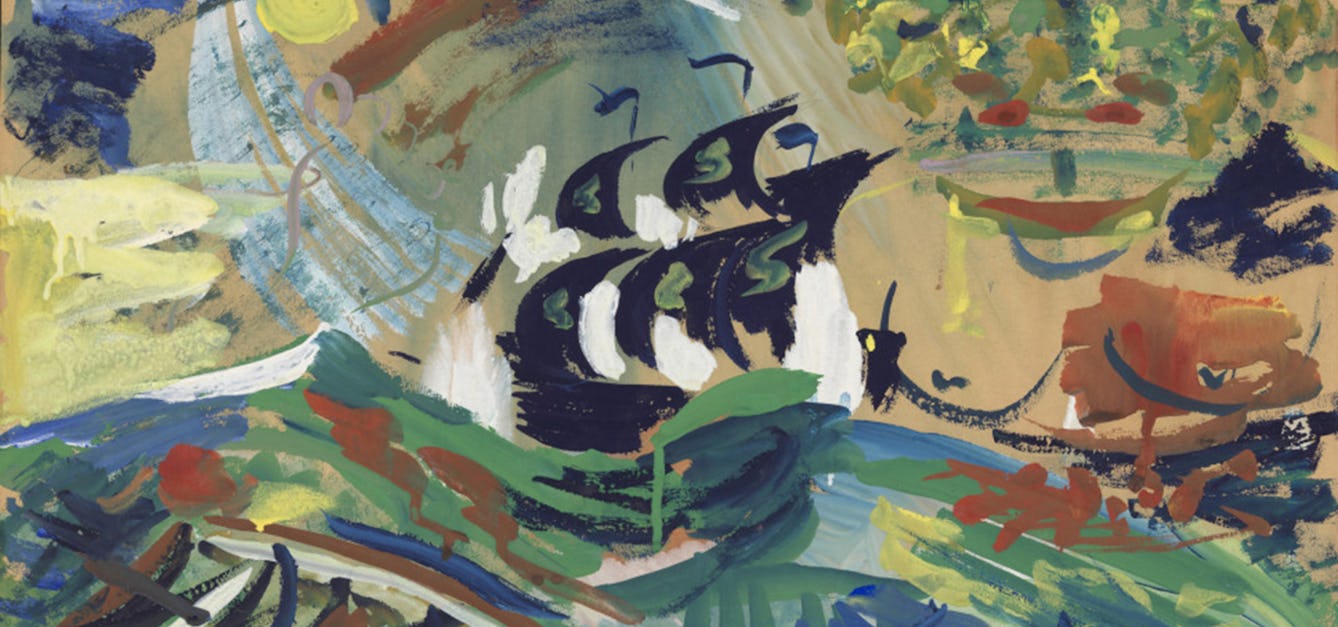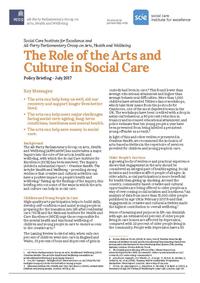Stories

- Photo story
Obesity and Britain’s boys
Six young men and six experiences of being overweight. Find out how these boys and their loved ones feel about this stigmatising issue.

- Article
Picturing mental health
Ron Hampshire created artworks while resident at Netherne psychiatric hospital. What can we learn from them?

- Article
Mary Bishop and the surveillant gaze
Writer and artist Rose Ruane explores the paintings of Mary Bishop, created during a 30-year stay in a psychiatric hospital, which speak of constant medical surveillance and censorious self-examination.

- Article
Migraine, creativity and me
Novelist Lydia Ruffles explores how migraine has made her mind stretch, shrink, widen and change, and how it’s influenced her art.
Catalogue
- Books
Hold still : a portrait of our nation in 2020.
Date: [2021]- Books
- Online
The Role of the Arts and Culture in Social Care : Policy Briefing July 2017 / All-Party Parliamentary Group on Arts, Health and Wellbeing, produced in partnership with Social Care Institute for Excellence.
All-Party Parliamentary Group on Arts, Health and WellbeingDate: 2017- Student dissertations
Resiliency through instability : reframing the histories of Edward Adamson and British art therapy / Katie Olivia Cohen.
Cohen, Katie OliviaDate: 2017- Books
Resiliency through instability : reframing the histories of Edward Adamson and British art therapy / Katie Olivia Cohen.
Cohen,Katie OliviaDate: 2017- Books
- Online
Creative health : the arts for health and wellbeing / All-Party Parliamentary Group on Arts, Health and Wellbeing.
All-Party Parliamentary Group on Arts, Health and WellbeingDate: 2017
![Scutellaria baicalensis Georgi Lamiaceae. Baikal skullcap. Distribution: China. There are several hundred species of Scutellaria, also known as skull caps, so correct identification is important - in particular from Scutellaria lateriflora an American species known as Blue skullcap. The latter is used as an abortifacient and to expel placenta by the Cherokee and for cleaning the throat by the Iroquois (Austin, 2004). Much vaunted as a treatment for rabies with unlikely statistics (1,400 cases cured by one doctor alone). Also as ‘antispasmodic, nervine, [for] chorea, convulsions, tetanus, tremors, delirium tremens, [and as a] diaphoretic and diuretic'. Toxicity symptoms include mental confusion, stupor, headache, vertigo, photophobia, dilated pupils, difficulty in micturition, bradycardia, tremulousness and languor, followed by wakefulness and restlessness (Milspaugh, 1974). Hutchens (1991) reported that it reduces sexual desire and was used for almost every nervous illness. Scutellaria baicalensis contains baicalin, baicalein and wogonin (European Medicines Agency, September 2010). It is used in Traditional Chinese Medicine for treating inflammation, cancer, bacterial and viral infections of the lungs and gut and is one of the '50 Chinese herbs' in the lists of some authors. Scutellaria lateriflora (combined with Verbena officinalis, Passiflora incarnata and the seed of Avena sativa (oats) is licensed for use in Britain as a herbal medicine for temporary relief of mild symptoms of stress such as mild anxiety and to aid sleep, based upon traditional use only. Scutellaria baicalensis is not licensed for use in the UK (UK Medicines and Healthcare Products Regulatory Agency (MHRA)). Photographed in the Medicinal Garden of the Royal College of Physicians, London.](https://iiif.wellcomecollection.org/image/B0009188/full/282%2C/0/default.jpg)
![Papaver somniferum L. Papaveraceae Opium Poppy Distribution: Asia minor, but has been dated to 5000BC in Spanish caves. Now grows almost everywhere. The oldest medicine in continuous use, described in the Ebers' papyrus (1550 BC), called Meconium, Laudanum, Paregoric and syrup of poppies. Culpeper (1650) on Meconium '...the juyce of English Poppies boyled till it be thick' and 'I am of the opinion that Opium is nothing else but the juyce of poppies growing in hotter countries, for such Opium as Authors talk of comes from Utopia.[he means an imaginary land, I suspect]’]. He cautions 'Syrups of Poppies provoke sleep, but in that I desire they may be used with a great deal of caution and wariness...' and warns in particular about giving syrup of poppies to children to get them to sleep. The alkaloids in the sap include: Morphine 12% - affects ?-opioid receptors in the brain and causes happiness, sleepiness, pain relief, suppresses cough and causes constipation. Codeine 3% – mild opiate actions – converted to morphine in the body. Papaverine, relaxes smooth muscle spasm in arteries of heart and brain, and also for intestinal spasm, migraine and erectile dysfunction. Not analgesic. Thebaine mildly analgesic, stimulatory, is made into oxycodone and oxymorphone which are analgesics, and naloxone for treatment of opiate overdose – ?-opioid receptor competitive antagonist – it displaces morphine from ?-opioid receptors, and constipation caused by opiates. Protopine – analgesic, antihistamine so relieves pain of inflammation. Noscapine – anti-tussive (anti-cough). In 2006 the world production of opium was 6,610 metric tons, in 1906 it was over 30,000 tons when 25% of Chinese males were regular users. The Opium wars of the end of the 19th century were caused by Britain selling huge quantities of Opium to China to restore the balance of payments deficit. Laudanum: 10mg of morphine (as opium) per ml. Paregoric: camphorated opium tincture. 0.4mg morphine per ml. Gee’s Linctus: up to 60 mg in a bottle. J Collis Browne’s chlorodyne: cannabis, morphine, alcohol etc. Kaolin and Morph. - up to 60 mg in a bottle. Dover’s Powders – contained Ipecacuana and morphine. Heroin is made from morphine, but converted back into morphine in the body (Oakeley, 2012). One gram of poppy seeds contains 0.250mgm of morphine, and while one poppy seed bagel will make a urine test positive for morphine for a week, one would need 30-40 bagels to have any discernible effect. Photographed in the Medicinal Garden of the Royal College of Physicians, London.](https://iiif.wellcomecollection.org/image/B0009101/full/282%2C/0/default.jpg)
![Papaver somniferum L. Papaveraceae Opium Poppy Distribution: Asia minor, but has been dated to 5000BC in Spanish caves. Now grows almost everywhere. The oldest medicine in continuous use, described in the Ebers' papyrus (1550 BC), called Meconium, Laudanum, Paregoric and syrup of poppies. Culpeper (1650) on Meconium '...the juyce of English Poppies boyled till it be thick' and 'I am of the opinion that Opium is nothing else but the juyce of poppies growing in hotter countries, for such Opium as Authors talk of comes from Utopia [he means an imaginary land, I suspect]’. He cautions 'Syrups of Poppies provoke sleep, but in that I desire they may be used with a great deal of caution and wariness...' and warns in particular about giving syrup of poppies to children to get them to sleep. The alkaloids in the sap include: Morphine 12% - affects ?-opioid receptors in the brain and causes happiness, sleepiness, pain relief, suppresses cough and causes constipation. Codeine 3% – mild opiate actions – converted to morphine in the body. Papaverine, relaxes smooth muscle spasm in arteries of heart and brain, and also for intestinal spasm, migraine and erectile dysfunction. Not analgesic. Thebaine mildly analgesic, stimulatory, is made into oxycodone and oxymorphone which are analgesics, and naloxone for treatment of opiate overdose – ?-opioid receptor competitive antagonist – it displaces morphine from ?-opioid receptors, and reverses the constipation caused by opiates. Protopine – analgesic, antihistamine so relieves pain of inflammation. Noscapine – anti-tussive (anti-cough). In 2006 the world production of opium was 6,610 metric tons, in 1906 it was over 30,000 tons when 25% of Chinese males were regular users. The Opium wars of the end of the 19th century were caused by Britain selling huge quantities of Opium to China to restore the balance of payments deficit. Laudanum: 10mg of morphine (as opium) per ml. Paregoric: camphorated opium tincture. 0.4mg morphine per ml. Gee’s Linctus: up to 60 mg in a bottle. J Collis Browne’s chlorodyne: cannabis, morphine, alcohol etc. Kaolin and Morph. - up to 60 mg in a bottle. Dover’s Powders – contained Ipecacuana and morphine. Heroin is made from morphine, but converted back into morphine in the body (Oakeley, 2012). One gram of poppy seeds contains 0.250mgm of morphine, and while one poppy seed bagel will make a urine test positive for morphine for a week, one would need 30-40 bagels to have any discernible effect. Photographed in the Medicinal Garden of the Royal College of Physicians, London.](https://iiif.wellcomecollection.org/image/B0009102/full/282%2C/0/default.jpg)








